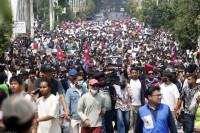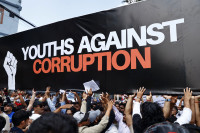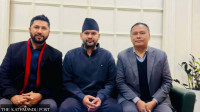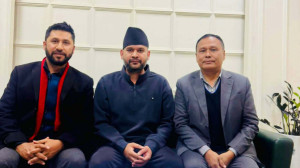Politics
Nepal’s opposition politics has been a saga of opportunism
The country’s post-1990 history is testament to the undemocratic nature of opposition parties, irrespective of their ideological bent.
Nishan Khatiwada
Raising public issues, analysing the laws proposed by the executive, and speaking up against the wrongdoings of the government in Parliament all fall under an opposition party’s chief responsibilities. But in Nepal, that is still a distant dream.
Regardless of their number of seats, all that the political parties, whether big or small, want is power, political observers say. This mad rush for power has pushed the concept of opposition to the brink of extinction, they add.
Now the new nine-party alliance—including the Nepali Congress, the CPN (Maoist Centre), the Unified Socialist, the Janata Samajbadi Party, the Loktantrik Samajbadi Party, the Janamat Party, the Nagarik Unmukti Party, the Rastriya Janamorcha and the Nepal Samajbadi Party—will become the new ruling coalition.
The CPN-UML, which pulled out of the government after being denied the presidential post by its partner CPN (Maoist Centre), meanwhile, will be in the opposition. It is nonetheless exploring every option to turn the tables in the March 9 presidential election and get back into the government.
The Rastriya Swatantra Party, which emerged out of the public’s frustration with the traditional parties, is also in no mood to stay as an opposition force in Parliament.
“Even the smaller parties which have the mandate to stay in opposition and raise public-interest issues want to join the government. They bargain with the larger parties, taking advantage of the numbers game,” said political analyst Mumaram Khanal. “So, Nepal has not seen an opposition that articulates the public’s voice.”
Another political analyst, Puranjan Acharya, echoed Khanal’s sentiments. “The opposition culture in Nepal has not been constructive.”
According to Khanal, an ideal opposition lends constructive support to the government’s good works and criticises it as and when needed. “They need to press the government to move on the right track. But they have not done so.”
Nepal’s history of oppositional politics began after the first parliamentary elections in 1959.
The National Democratic Front formed by the Nepal Praja Parishad, the United Democratic Party and the Nepal Prajatantrik Mahasabha were established as opposition to the Nepali Congress’ majority government formed after the elections. The opposition back then wanted to immediately do away with the elected government.
Somewhat better as an opposition party was the Gorkha Parishad, said political historian Rajesh Gautam. “They were active in parliament. They even ran a newspaper called Rastrabani. They spoke up on national issues, including in cases of the Sagarmatha [dispute with China] and Nepal-India relations,” Gautam said.
After King Mahendra introduced the partyless Panchayat system in 1961, banning the political parties, opposition politics also went underground. There was no environment to openly protest and oppose the monarchy. Activities of political parties such as the Nepali Congress and the communist parties were banned and therefore, limited.
When the Congress formed a majority government after the 1991 elections following the restoration of multiparty democracy in 1990, the UML became the main opposition.
Political parties were practising multi-party democracy after a gap of 30 years and most leaders were new to the system. The UML as an opposition was active, but it took an aggressive approach, taking to the streets for aggressive nationwide protests.
Political analyst Puranjan Acharya said the culture of obstructing parliament has been established since the 1990 political changes. “UML adopted the strategy of opposition from the streets. That was not at all constructive or creative,” he said.
Internal feuds of ruling parties and the wrong approach of the opposition parties helped the palace undermine the parliamentary system in many cases. Mostly, the communist parties boycotted and disturbed House proceedings.
The parliament elected after the 1994 polls saw less active opposition. The parliament had pretty much been reduced to a place for making and breaking governments. “All parties wanted to get into the government. The opposition parties only focused on toppling the government and getting to power themselves,” said Gautam, the political historian.
“After the 1994 elections, no one wanted to stay in the opposition. The Congress, when in opposition, acted pretty much as the UML did,” said Acharya.
When King Gyanendra usurped power in 2002 and 2005, he again tried to restrict opposition voices. But the political parties were not banned. After that, the country saw a movement in 2006-2007, which laid the ground for the abolition of monarchy. In May 2008, Nepal became a republic and has now adopted a federal set-up. Many governments have come and gone, but the country is yet to see any political party play the role of an effective opposition.
“Nepal’s constitutions have also given the opposition party an executive role, for instance during constitutional appointments, which has only increased political horse-trading,” said Acharya. The leader of the main opposition is an ex-officio member of the Constitutional Council that nominates heads and members of constitutional bodies, chief justice.
After a heavy defeat in the 2017 polls, the Congress was confined to opposition benches, while the erstwhile Nepal Communist Party led the government with almost two-thirds majority. But the Congress was too busy with infighting.
At the time, Congress President Sher Bahadur Deuba was roundly criticised in and outside the party, allegedly for his reluctance to protest KP Sharma Oli’s House dissolution. Deuba was adamant that the party wait for the Supreme Court’s verdict on the issue, despite demands from key party leaders that they should take to the streets. While the main opposition failed to play its part, Congress leaders accused Deuba of cosying up to Oli to secure important appointments for his loyalists.
The party was also mum when the country was being ravaged by the Covid pandemic.
After that, the Nepali Congress led the government with Deuba as prime minister. The UML was the main opposition and it again obstructed the House, greatly affecting parliamentary business. On August 17, 2021, the UML asked Speaker Agni Prasad Sapkota to strip the 14 lawmakers who had split the UML to form the CPN (Unified Socialist) of their positions. After Sapkota’s refusal, the UML started agitating and disrupted the House, and the lower house could conclude no business for eight months.
The UML broke its own record for the longest obstruction of the House of Representatives. Previously, it had blocked the House for 57 days in 2001, demanding the resignation of the then prime minister Girija Prasad Koirala over the infamous Lauda Air scam.
The Maoist Centre’s opposition politics was marked by violence. The party has been in almost all the governments since the 2008 Constituent Assembly elections. In 2010, after the Dahal-led Maoist party was forced to leave the government, the party resorted to street protests, which were often violent. They took to the streets and demonstrated nationwide to unseat the then prime minister, Madhav Kumar Nepal.
In the post-2014 phase, the UCPN Maoist, while leading an alliance of parties, had tried to disrupt CA proceedings ahead of the constitution drafting process.
If a political party plays the role of an effective opposition, it can win people’s hearts and brighten its electoral prospects, says political analyst Acharya.
“While the executive is focused on bringing laws, the opposition’s duty is to analyse whether the proposed laws are right or wrong, in line with public sentiments. They can emerge strong in the next elections if they play the role of an effective opposition,” said Gautam.
The Madhesh-based parties’ politics is the biggest example of this trend—as well as its antithesis.
Whenever Madhesh-based parties were involved in movements and carried anti-establishment sentiments while in the opposition, they fared well electorally. But after joining the government, they failed to deliver and forgot their original agendas. As a result, they fared badly in the next elections. In the first CA elections, they had a combined strength of 81 seats. That was after they had agitated against the Interim Constitution and succeeded in including the agenda of federalism in it.
After facing splits, and getting deep into power politics, they won only around half the seats in the next polls. Again, the Madhesh-based parties strongly opposed the 2015 Constitution and began agitation against it. Though they had joined some governments, they had also been pressing for constitutional amendments. The Rastriya Janata Party had won 17 seats, while the Sanghiya Samajbadi Forum also won 16 seats in the 275 member federal parliament in the 2017 polls.
Now, these Madhesh-based outfits have only 22 seats in the lower house—the Janata Samajbadi Party has 11, Loktantrik Samajbadi Party five and the newly-emerged Janamat Party has six.
“The Madhesh-based parties left the public on the road. They lured voters by strongly opposing their oppression by the state. However, in their subsequent mad rush for power, they again lost their credibility,” said Acharya.




 7.12°C Kathmandu
7.12°C Kathmandu













%20(1).jpg&w=300&height=200)

